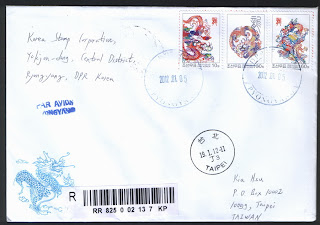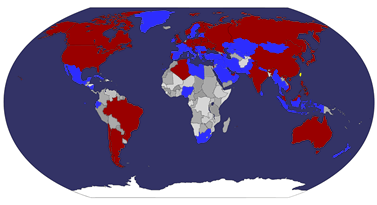Chunghwa Post previously issued two sets of stamps on long-horned beetles on May 21, 2010 and January 26, 2011 respectively. This third set of four stamps, featuring four kinds of them which are endemic to Taiwan, Leptura formosomontana formosomontana, Pyrestes curticornis, Anaglyptus meridionalis, and Anoplophora albopicta, will be released on March 9, 2012. The designs follow:
1. Leptura formosomontana formosomontana (NT$7): This beetle has a black body with eight yellow markings on its elytra. Unlike most males of the genus, the end of the abdomen of this species is shorter than its elytra. It is found in broad-leaved forests and coniferous broad-leaved mixed forests at around 2,000 meters above sea level. An adult is typically about 1.6 to 1.9 centimeters long.
2. Pyrestes curticornis (NT$12): This beetle has a red body and a pair of dark-red flat and jagged antennae. Some individuals in this species have black antennae. The surface of its elytra is covered with stippling and fine red hair. The species is found in broad-leaved forests between the coastal plain and 1,400 meters above sea level. An adult is typically about 1.5 to 1.8 centimeters long.
3. Anaglyptus meridionalis (NT$15): This beetle has a bright red body. Its pronotum and elytra are covered with many black markings encircled by fine golden yellow and white hair. Its antennae are black overall, but the base of each segment is white. The species is found in broad-leaved forests and coniferous broad-leaved mixed forests between 1,200 and 2,400 meters above sea level. An adult is typically about 1.5 to 1.8 centimeters long.
4. Anoplophora albopicta (NT$20): This large beetle has a black body with a violet-blue or violet-green metallic sheen. Its head, antennae, and elytra are all black, but the base of each of its antennae segments is white. There are some sharp spurs on the outer edges of its prothorax. The surfaces of its elytra are smooth and dotted with white spots. The species is found in broad-leaved forests between the coastal plain and 2,000 meters above sea level. An adult is typically about 4.3 to 5.7 centimeters long.






























.jpg)












































 taiwan
taiwan  cover or postcard
cover or postcard  FDC
FDC 





























































































